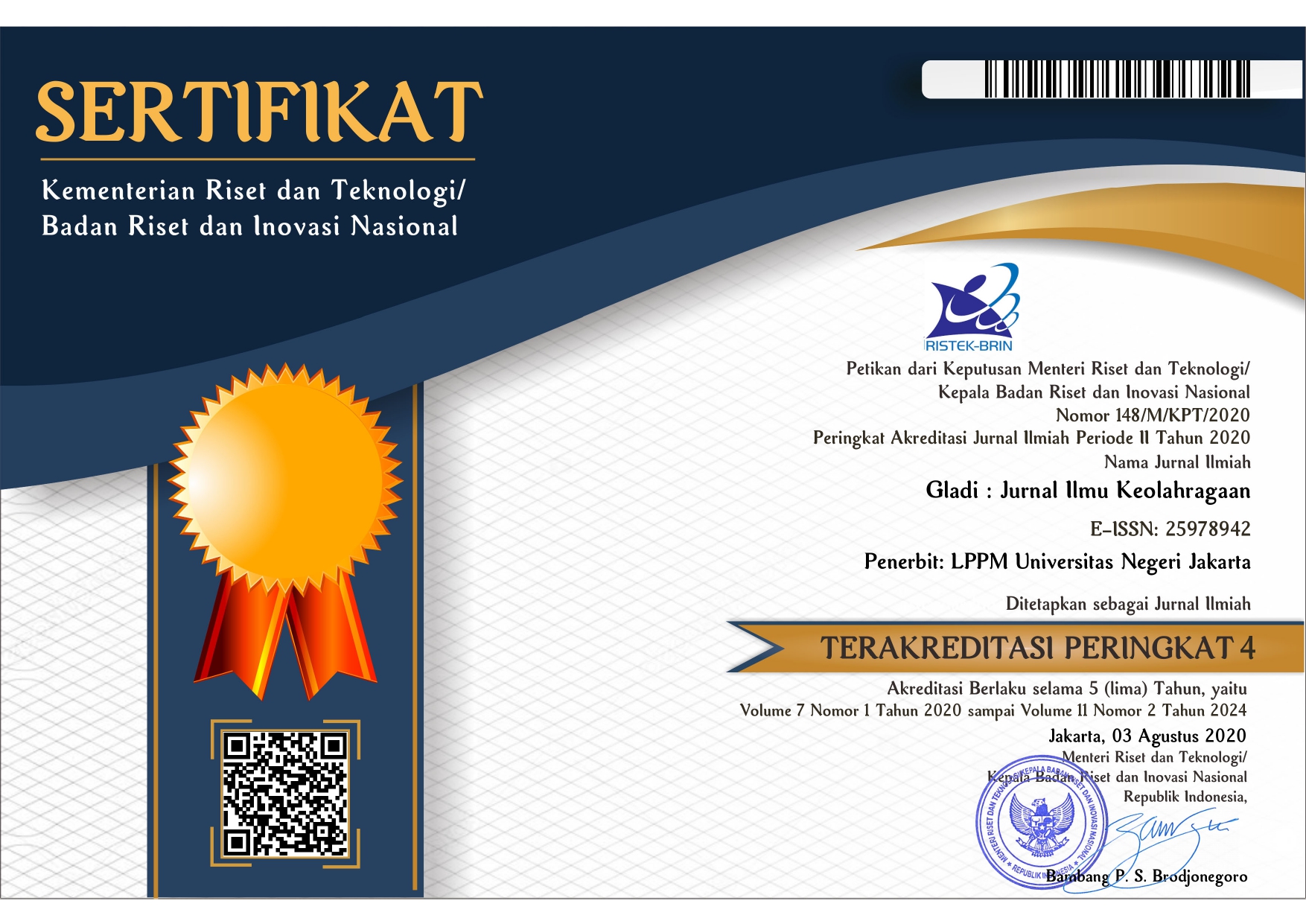Pengaruh Latihan Olahraga Rekreasi dan Kesehatan Terhadap Karakteristik Antropometri dan Respon Stres pada Korban Bencana Tsunami di Kabupaten Pandegglang, Banten
DOI:
https://doi.org/10.21009/GJIK.112.02Keywords:
Bencana alam, kebugaran, wabah penyakit, preventif.Abstract
Menurut Badan Nasional Penaggulangan Bencana (BNPB), sepanjang tahun 2005 sampai dengan tahun 2015, Indonesia mencatatkan kejadian sebanyak 78% (11.648) bencana hidrometeorologi dan sekitar 22% (3.810) merupakan bencana geologi. Maka dari itu, tujuan penelitian ini untuk mengetahui pengaruh latihan olahraga rekreasi dan kesehatan terhadap karakteristik antropometri dan respon stres pada masyarakat di Kecamatan Sumur, Kabupaten Pandegglang, Provinsi Banten. Uji t-test menunjukkan bahwa tidak ada perubahan yang signifikan antara pre dan post-treatment, untuk tinggi badan (p = 0,843), berat badan (p = 0,955), BMI (p = 0,822), tekanan sitolik (p = 0,941), dan tekan diastolik (p = 0,834). Serta terdapat penurunan secara signifikan terhadap skala kebosanan dari rata-rata 4,8 ± 0,35 menjadi 3,3 ± 0,49, dengan taraf perbedaan (p = 0,001). Dalam parameter lainnya, meskipun terdapat penurunan pada kecemasan (p = 0,533), kesedihan (p = 0,075), kekhawatiran (p = 0,285), dan overthinking (p = 0,571) namun statistik analisis tidak menujukkan perbedaan pada ke-empat variable tersebut. Observasi yang kami lakukan menyimpulkan bahwa, melakukan olahraga rekreasi dan kesehatan selama 15 hari dapat menurunkan secara signifikan terhadap tingkat kebosanan, serta terdapat penurunan terhadap tingkat kecemasan, kesedihan, kekhawatiran, dan overthinking namun tidak signifikan. Dalam pengukuran anthropometry dan tekanan darah, peneltian ini menunjukkan tidak terjadi perubahan yang signifikan pada dua variable pengukuran tersebut.
Downloads
References
BNPB. (2016). Risiko bencana indonesia.
Church, D., Feinstein, D., Palmer-Hoffman, J., Stein, P. K., & Tranguch, A. (2014). Empirically supported psychological treatments the challenge of evaluating clinical innovations. Journal of Nervous and Mental Disease, 202(10), 699–709. https://doi.org/10.1097/NMD.0000000000000188
Church, D., Stapleton, P., Mollon, P., Feinstein, D., Boath, E., Mackay, D., & Sims, R. (2018). Guidelines for the Treatment of PTSD Using Clinical EFT (Emotional Freedom Techniques). Healthcare, 6(4), 146. https://doi.org/10.3390/healthcare6040146
Clond, M. (2016). Emotional freedom techniques for anxiety a systematic review with meta-analysis. Journal of Nervous and Mental Disease, 204(5), 388–395. https://doi.org/10.1097/NMD.0000000000000483
Dunlop, B. W., Kaye, J. L., Youngner, C., & Rothbaum, B. (2014). Assessing treatment-resistant posttraumatic stress disorder: The emory treatment resistance interview for PTSD (E-TRIP). Behavioral Sciences, 4(4), 511–527. https://doi.org/10.3390/bs4040511
Eftekhari, A., Ruzek, J. I., Crowley, J. J., Rosen, C. S., Greenbaum, M. A., & Karlin, B. E. (2013). Effectiveness of national implementation of prolonged exposure therapy in veterans affairs care. JAMA Psychiatry, 70(9), 949–955. https://doi.org/10.1001/jamapsychiatry.2013.36
Izumikawa, K. (2019). Infection control after and during natural disaster. Acute Medicine & Surgery, 6(1), 5–11. https://doi.org/10.1002/ams2.367
Kessler, R. C., Aguilar-Gaxiola, S., Alonso, J., Benjet, C., Bromet, E. J., Cardoso, G., … Koenen, K. C. (2017). Trauma and PTSD in the WHO World Mental Health Surveys. European Journal of Psychotraumatology, 8. https://doi.org/10.1080/20008198.2017.1353383
Morina, N., Wicherts, J. M., Lobbrecht, J., & Priebe, S. (2014). Remission from post-traumatic stress disorder in adults: A systematic review and meta-analysis of long term outcome studies. Clinical Psychology Review, 34(3), 249–255. https://doi.org/10.1016/j.cpr.2014.03.002
Ramania, N. S., Iwo, M. I., Apriantono, T., & Winata, B. (2020). The effect of social interaction and environment during aerobic dance on salivary cortisol. Physiotherapy Quarterly, 28(3), 14–20. https://doi.org/10.5114/PQ.2020.95770
Reisman, M. (2016). PTSD treatment for veterans: What’s working, what’s new, and what’s next. P and T, 41(10), 623–634.
Santiago, P. N., Ursano, R. J., Gray, C. L., Pynoos, R. S., Spiegel, D., Lewis-Fernandez, R., … Fullerton, C. S. (2013). A Systematic Review of PTSD Prevalence and Trajectories in DSM-5 Defined Trauma Exposed Populations: Intentional and Non-Intentional Traumatic Events. PLoS ONE, 8(4), 1–5. https://doi.org/10.1371/journal.pone.0059236
Shalev, A., Liberzon, I., & Marmar, C. (2017). Post-traumatic stress disorder. New England Journal of Medicine, 376(25), 2459–2469. https://doi.org/10.1056/NEJMra1612499
Zouhal, H., Saeidi, A., Salhi, A., Li, H., Essop, M. F., Laher, I., … Ben Abderrahman, A. (2020). <p>Exercise Training and Fasting: Current Insights</p>. Open Access Journal of Sports Medicine, Volume 11, 1–28. https://doi.org/10.2147/oajsm.s224919







